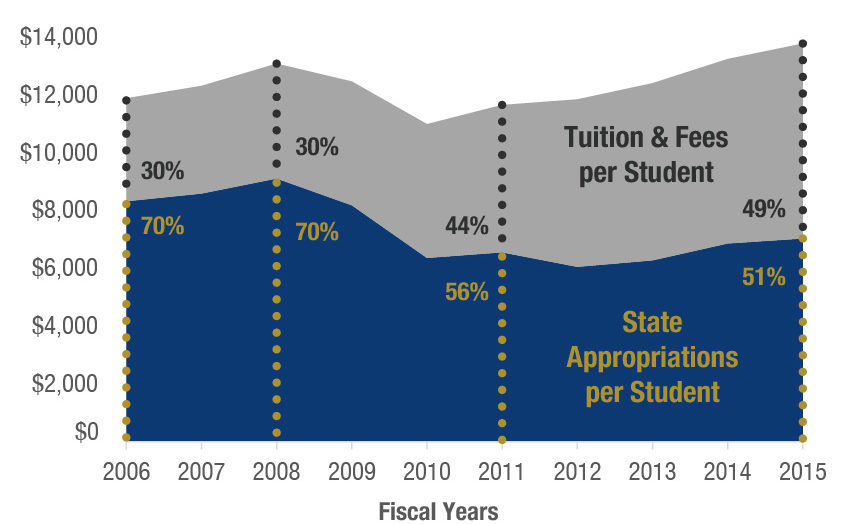Georgia’s university system Board of Regents is set to meet this month to decide on tuition rates for the 2017-2018 school year. At the beginning of the legislative session, the university system chancellor assured the Legislature that any tuition increase decided this spring would be low.
But why does the price of attending a Georgia college keep going up?
The rise is directly tied to a steady drop in state funding for universities in Georgia, which are shifting a greater share of costs to students and families, according to a state audit report published last December.
State appropriations to the University System of Georgia declined by 15 percent since 2006, or $1,288 per student, according to the Georgia Department of Audits and Accounts report. To make up for that decrease, universities raised tuition rates. Picture squeezing one side of a balloon. When the state squeezes appropriations, the pressure increases on tuition and fees paid for by Georgia students.
Universities in Georgia receive most of their money from state appropriations, grants and contracts, and tuition and fees. Despite rising costs for families, the report found the university system total revenue per student has remained consistent with inflation over the past ten years. What has changed is the mix of who contributes those dollars.
Ten years ago, the state supported 70 percent of the state’s higher education costs. Spurred by state budget cuts after the recession, this percentage declined by nearly 20 percentage points, increasing pressure on students and leading to higher tuition and fees.
State Funding Cuts Increasing Share of College Costs Students Pay

After adjusting for inflation, tuition increases did not make up for decreases in state funding, leaving a $379 per-student funding deficit, the report says. Over the same period, colleges and universities reduced per-student spending on activities supported by tuition and appropriations, namely instruction and public service. (Public service includes academic activities such as continuing education and university system extension services.)
A mandatory Special Institutional Fee, which supports academic programs, functions as “an alternative form of tuition,” the report says. After the recession prompted lawmakers to slash the state budget, the state Board of Regents instituted the mandatory fee to make up for state funding cuts in higher education. Without a larger share of support from the state, universities continue to rely on the new fee, in addition to tuition, to help pay for academic programs.
Beyond tuition – fees for self-sustaining, non-academic programs and services also rising
Although tuition usually makes up the biggest chunk of college cost, the full price can include housing and dining plans for some students. Many Georgia schools also charge fees that support a range of programs and services, such as facilities, athletic programs, student health and transportation services.
By law, these non-academic programs and services must be self-sustaining through fee revenue. The costs and fees in many of these in-demand programs have increased. The Board of Regents recently adopted policies to slow these rising costs by limiting the amount of debt institutions can issue for facilities funded by student fees, restricting growth in athletics expenses, and using pooled food services contracts.
Declines in HOPE Program further shifts costs to students
The role the HOPE program plays in defraying college costs also drew attention from state auditors. The lottery-funded HOPE program is not technically part of the university system’s budget, but it helps many Georgia residents pay tuition. Both the number of HOPE scholarships and the award amounts have decreased in recent years. In 2012, the Georgia Legislature reduced the award amount of HOPE scholarships and eliminated HOPE awards for student fees and book expenses.
Bottom Line: Universities’ costs to provide an education are higher than the price students pay.
The state is pursuing an ambitious higher education agenda through its Complete College Georgia program, which aims for an increase in the share of Georgians with postsecondary credentials from 42 to 60 percent by 2025. As the state decreases its share of the cost to meet that goal, financial pressure continues to increase on students and families to make up the difference.








